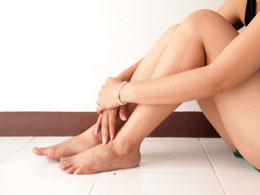Leg pain accompanying menstruation is a common complaint among a lot of women all over the world. Let's get to the details to find out what causes it and how it can be managed.
 In man, the shedding of blood is always associated with injury, disease, or death. Only the female half of humanity was seen to have the magical ability to bleed profusely and still rise phoenix-like each month from the gore.
In man, the shedding of blood is always associated with injury, disease, or death. Only the female half of humanity was seen to have the magical ability to bleed profusely and still rise phoenix-like each month from the gore. ~ Estelle R. Ramey
Indeed! And as much as they may feel like a curse, this monthly bleeding is the blessing of Nature that was bestowed upon Womankind in a fit of cosmic partiality. Not only does the menstrual cycle mark women as the project managers of New Life (well, men do contribute but their investment is like that of a venture capitalist.... if you know what I mean!) on Earth, the entire cycle is a complex mechanism of hormonal interactions inside the body that helps women stay healthy overall. Now, blood loss is not the only issue that weigh women down during those 3 to 7 days every month. There are various other problems that occur during this cycle such as abdominal cramps, lower back pain, mood swings, nausea, headaches, bloating, numbness and pain along the thighs and legs, etc. Speaking of leg pain associated with periods, this is the third most common physical discomfort (associated with menstrual cycle) that a lot of women face after abdominal cramps and lower back pain. Let's take a look at what causes this condition and how to manage such pain in the upcoming segment.
Causes
Leg pain around menstruation (before or during and, rarely, after periods) may be caused by a lot of factors. Let's take a look at some common and identified factors that cause pain in thighs and legs which usually occur along the rear portions.
Hormonal Medications: Medications and supplements that contain female hormones estrogen and progesterone or ingredients that mimic the actions of these hormones can lead to leg pain and lower back pain in women during their periods. That is the reason why most women who take oral contraceptive pills or get contraceptive implants often complain of numbness and/or pain along the back portions of their legs and thighs during or before menstruation. This also applies for women who undergo hormone therapy involving estrogen or progesterone.
Pre-Menstruation Indication: Slight pain, cramping or a
heavy feeling along the back of the hips that runs along the thighs and upper legs are often among the many symptoms that precede menstruation - that time of the month when the uterus expels its blood-rich lining which had formed therein in anticipation of fertilization during ovulation.
Nutritional Deficiency: Similar to abdominal cramping and excessive bleeding, leg and thigh numbness and pain are often associated with a low iron and calcium level in the body. Add physical exertion and stress to this and the result is an overall feeling of physical discomfort. Most often, leg pain during periods brought on by nutritional deficiency is usually accompanied with a mild to moderate pain along the lower back and the pelvic region, usually along the back and the sides.
Other Medical Conditions: Leg cramps and pain may occur during periods and also during ovulation, if a person suffers from endometriosis. In this condition, the cells and tissues that make up the uterine lining (endometrium) begin appearing elsewhere in the body, especially around the reproductive organs. Ovaries are most prone to these kinds of growths. These growths are influenced by the estrogen cycle and they bleed during menstruation. Also, uterine contractions during periods may put pressure on the nerves of the legs since the nerves of the uterus and lower limbs travel along a common pathway.
Remedies
Most instances of leg pain during periods are harmless and do not pose any threat other than mild to moderate physical discomfort. These can be relieved by application of heating pads or pain relieving ointments. Generic analgesics like
ibuprofen may be taken to relieve persistent or slightly severe pain. In case of unbearable pain and cramps, medical attention should be sought without delay. Any abnormal pattern in these pains and cramps also warrant gynecological consultation and physical checkup.
Menstruation-related leg and back pain can also be avoided and their intensity can be reduced by maintaining a healthy body weight. Regular exercise, balanced diet, and a healthy lifestyle go a long way in ensuring that your body goes through as little discomfort as possible during those 5 to 7 days each month. This might come as a surprise to you but I do know a lot of women who have never had a single complaint pertaining to their health or physical condition during their periods; they hardly feel any different than they would for the rest of the month!
Disclaimer:
This article is for informational purposes only, and should not be used as a replacement for expert medical advice.


 In man, the shedding of blood is always associated with injury, disease, or death. Only the female half of humanity was seen to have the magical ability to bleed profusely and still rise phoenix-like each month from the gore. ~ Estelle R. Ramey
In man, the shedding of blood is always associated with injury, disease, or death. Only the female half of humanity was seen to have the magical ability to bleed profusely and still rise phoenix-like each month from the gore. ~ Estelle R. Ramey